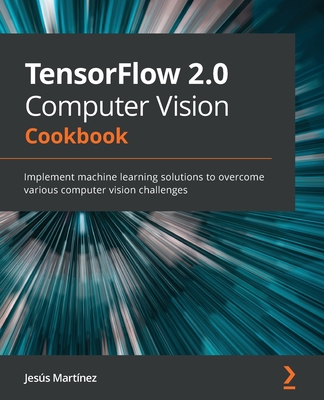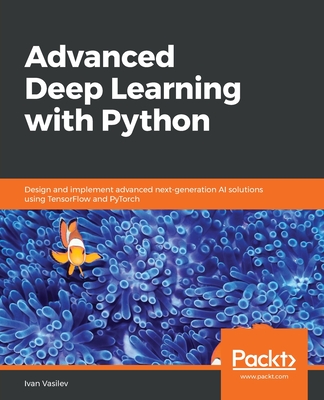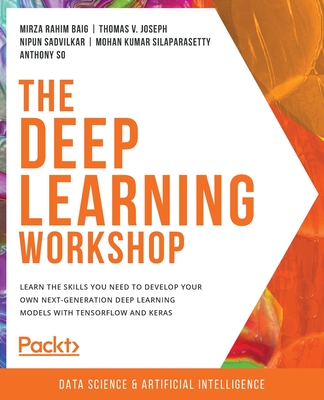Hands-On Convolutional Neural Networks with TensorFlow: Solve computer vision problems with modeling in TensorFlow and Python.
暫譯: 實作卷積神經網路與 TensorFlow:使用 TensorFlow 和 Python 解決電腦視覺問題。
Iffat Zafar, Giounona Tzanidou, Richard Burton, Nimesh Patel, Leonardo Araujo
- 出版商: Packt Publishing
- 出版日期: 2018-08-29
- 售價: $1,320
- 貴賓價: 9.5 折 $1,254
- 語言: 英文
- 頁數: 272
- 裝訂: Paperback
- ISBN: 1789130336
- ISBN-13: 9781789130331
-
相關分類:
TensorFlow
海外代購書籍(需單獨結帳)
買這商品的人也買了...
-
 電路板電氣測試與AOI檢驗技術簡介
電路板電氣測試與AOI檢驗技術簡介$1,500$1,425 -
 $1,188Fedora 11 and Red Hat Enterprise Linux Bible (Paperback)
$1,188Fedora 11 and Red Hat Enterprise Linux Bible (Paperback) -
 離散數學 最新修訂版
離散數學 最新修訂版$800$680 -
 自動化光學檢測
自動化光學檢測$520$494 -
 Python 設計模式深入解析 (Mastering Python Design Patterns)
Python 設計模式深入解析 (Mastering Python Design Patterns)$360$281 -
 不再聽不懂!圖解網站建置與開發
不再聽不懂!圖解網站建置與開發$450$383 -
 演算法之美:隱藏在資料結構背後的原理 (C++版)
演算法之美:隱藏在資料結構背後的原理 (C++版)$650$507 -
 Python 技術者們 - 實踐! 帶你一步一腳印由初學到精通
Python 技術者們 - 實踐! 帶你一步一腳印由初學到精通$650$553 -
 Hands-On Computer Vision with Tensorflow 2
Hands-On Computer Vision with Tensorflow 2$1,395$1,325 -
 設計師都該懂的包容性網頁 UI/UX 設計模式:知名設計師教你親和性網頁的實作祕密
設計師都該懂的包容性網頁 UI/UX 設計模式:知名設計師教你親和性網頁的實作祕密$450$351 -
 JavaScript 技術手冊
JavaScript 技術手冊$560$420 -
 PowerShell 流程自動化攻略 (Powershell for Sysadmins: A Hands-On Guide to Automating Your Workflow)
PowerShell 流程自動化攻略 (Powershell for Sysadmins: A Hands-On Guide to Automating Your Workflow)$500$425 -
 Deep Learning from the Basics
Deep Learning from the Basics$1,530$1,454 -
 資料密集型應用系統設計 (Designing Data-Intensive Applications: The Big Ideas Behind Reliable, Scalable, and Maintainable Systems)
資料密集型應用系統設計 (Designing Data-Intensive Applications: The Big Ideas Behind Reliable, Scalable, and Maintainable Systems)$980$774 -
 精通資料視覺化 : 用試算表與程式說故事 (Hands-On Data Visualization: Interactive Storytelling from Spreadsheets to Code)
精通資料視覺化 : 用試算表與程式說故事 (Hands-On Data Visualization: Interactive Storytelling from Spreadsheets to Code)$680$537 -
 打下最紮實 AI 基礎不依賴套件:手刻機器學習神經網路穩健前進
打下最紮實 AI 基礎不依賴套件:手刻機器學習神經網路穩健前進$1,200$948 -
 強健的 Python|撰寫潔淨且可維護的程式碼 (Robust Python: Write Clean and Maintainable Code)
強健的 Python|撰寫潔淨且可維護的程式碼 (Robust Python: Write Clean and Maintainable Code)$680$537 -
 Template Metaprogramming with C++: Learn everything about C++ templates and unlock the power of template metaprogramming (Paperback)
Template Metaprogramming with C++: Learn everything about C++ templates and unlock the power of template metaprogramming (Paperback)$1,740$1,653 -
 邁向 Linux 工程師之路:Superuser 一定要懂的技術與運用, 3/e (How Linux Works : What Every Superuser Should Know, 3/e)
邁向 Linux 工程師之路:Superuser 一定要懂的技術與運用, 3/e (How Linux Works : What Every Superuser Should Know, 3/e)$780$608 -
 精通無瑕程式碼:工程師也能斷捨離!消除複雜度、提升效率的 17個關鍵技法 (The Art of Clean Code: Best Practices to Eliminate Complexity and Simplify Your Life)
精通無瑕程式碼:工程師也能斷捨離!消除複雜度、提升效率的 17個關鍵技法 (The Art of Clean Code: Best Practices to Eliminate Complexity and Simplify Your Life)$600$468 -
 軟體設計耦合的平衡之道:建構模組化軟體系統的通用設計原則 (Balancing Coupling in Software Design: Successful Software Architecture in General and Distributed Systems)
軟體設計耦合的平衡之道:建構模組化軟體系統的通用設計原則 (Balancing Coupling in Software Design: Successful Software Architecture in General and Distributed Systems)$650$507 -
 深入淺出軟體架構 (Head First Software Architecture)
深入淺出軟體架構 (Head First Software Architecture)$980$774 -
 生成式 AI 提示工程|以前瞻性的設計打造穩定、可信任的 AI 解決方案 (Prompt Engineering for Generative AI: Future-Proof Inputs for Reliable AI Outputs)
生成式 AI 提示工程|以前瞻性的設計打造穩定、可信任的 AI 解決方案 (Prompt Engineering for Generative AI: Future-Proof Inputs for Reliable AI Outputs)$880$695 -
 我輩程式人:回顧從 Ada 到 AI 這條程式路,程式人如何改變世界的歷史與未來展望 (We, Programmers: A Chronicle of Coders from Ada to AI)
我輩程式人:回顧從 Ada 到 AI 這條程式路,程式人如何改變世界的歷史與未來展望 (We, Programmers: A Chronicle of Coders from Ada to AI)$850$638 -
 LLM 語意理解與生成技術完全開發 (Hands-On Large Language Models)
LLM 語意理解與生成技術完全開發 (Hands-On Large Language Models)$980$774
商品描述
Learn how to apply TensorFlow to a wide range of deep learning and Machine Learning problems with this practical guide on training CNNs for image classification, image recognition, object detection and many computer vision challenges.
Key Features
- Learn the fundamentals of Convolutional Neural Networks
- Harness Python and Tensorflow to train CNNs
- Build scalable deep learning models that can process millions of items
Book Description
Convolutional Neural Networks (CNN) are one of the most popular architectures used in computer vision apps. This book is an introduction to CNNs through solving real-world problems in deep learning while teaching you their implementation in popular Python library - TensorFlow. By the end of the book, you will be training CNNs in no time!
We start with an overview of popular machine learning and deep learning models, and then get you set up with a TensorFlow development environment. This environment is the basis for implementing and training deep learning models in later chapters. Then, you will use Convolutional Neural Networks to work on problems such as image classification, object detection, and semantic segmentation.
After that, you will use transfer learning to see how these models can solve other deep learning problems. You will also get a taste of implementing generative models such as autoencoders and generative adversarial networks.
Later on, you will see useful tips on machine learning best practices and troubleshooting. Finally, you will learn how to apply your models on large datasets of millions of images.
What you will learn
- Train machine learning models with TensorFlow
- Create systems that can evolve and scale during their life cycle
- Use CNNs in image recognition and classification
- Use TensorFlow for building deep learning models
- Train popular deep learning models
- Fine-tune a neural network to improve the quality of results with transfer learning
- Build TensorFlow models that can scale to large datasets and systems
Who this book is for
This book is for Software Engineers, Data Scientists, or Machine Learning practitioners who want to use CNNs for solving real-world problems. Knowledge of basic machine learning concepts, linear algebra and Python will help.
Table of Contents
- Setup and introduction to TensorFlow
- Deep Learning and Convolutional Neural Networks
- Image Classification in Tensorflow
- Object Detection and Segmentation
- VGG, Inception Modules, Residuals, and MobileNets
- Autoencoders, Variational Autoencoders, and Generative Adversarial Networks
- Transfer Learning
- Machine Learning Best Practices and Troubleshooting
- Training at Scale
商品描述(中文翻譯)
學習如何將 TensorFlow 應用於各種深度學習和機器學習問題,這本實用指南將指導您訓練 CNN 進行圖像分類、圖像識別、物體檢測以及許多計算機視覺挑戰。
主要特點
- 學習卷積神經網絡的基本原理
- 利用 Python 和 TensorFlow 訓練 CNN
- 構建可擴展的深度學習模型,能夠處理數百萬個項目
書籍描述
卷積神經網絡(CNN)是計算機視覺應用中最受歡迎的架構之一。本書通過解決深度學習中的現實問題來介紹 CNN,同時教您如何在流行的 Python 庫 TensorFlow 中實現它們。在本書結束時,您將能夠迅速訓練 CNN!
我們首先概述流行的機器學習和深度學習模型,然後幫助您設置 TensorFlow 開發環境。這個環境是後面章節中實現和訓練深度學習模型的基礎。接著,您將使用卷積神經網絡來解決圖像分類、物體檢測和語義分割等問題。
之後,您將使用遷移學習來了解這些模型如何解決其他深度學習問題。您還將體驗實現生成模型,如自編碼器和生成對抗網絡。
稍後,您將看到有關機器學習最佳實踐和故障排除的有用提示。最後,您將學習如何在數百萬張圖像的大型數據集上應用您的模型。
您將學到什麼
- 使用 TensorFlow 訓練機器學習模型
- 創建在其生命週期中能夠演變和擴展的系統
- 在圖像識別和分類中使用 CNN
- 使用 TensorFlow 構建深度學習模型
- 訓練流行的深度學習模型
- 通過遷移學習微調神經網絡以提高結果質量
- 構建可擴展到大型數據集和系統的 TensorFlow 模型
本書適合誰
本書適合希望使用 CNN 解決現實問題的軟體工程師、數據科學家或機器學習從業者。對基本機器學習概念、線性代數和 Python 的了解將有所幫助。
目錄
- TensorFlow 的設置與介紹
- 深度學習與卷積神經網絡
- 在 TensorFlow 中的圖像分類
- 物體檢測與分割
- VGG、Inception 模塊、殘差網絡與 MobileNets
- 自編碼器、變分自編碼器與生成對抗網絡
- 遷移學習
- 機器學習最佳實踐與故障排除
- 大規模訓練









